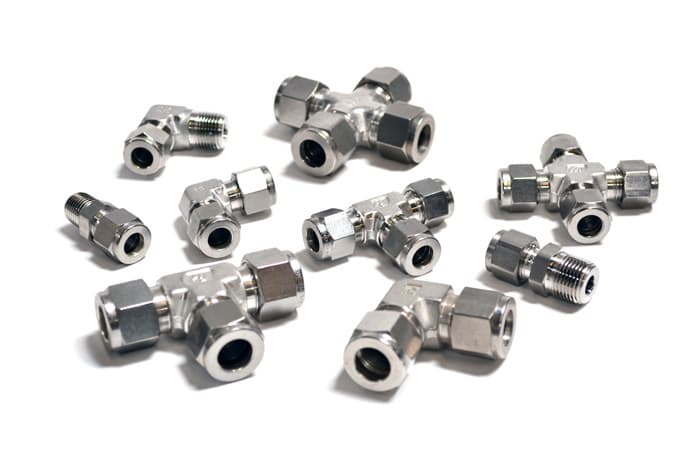What are Compression Fittings?

Image Description: An image showing Titan Compression Fittings
A compression fitting is a type of pipe joint that uses an external screw thread to compress the two ends together. Compression fittings are used for low-pressure applications, typically ranging from -5 psi to 125 psi. They are commonly used in refrigeration, air conditioning, and plumbing systems because they can be easily disassembled for maintenance or replacement if corrosion occurs.
Unlike other types of joints, compression fittings do not need additional sealing materials like gaskets or o-rings because they seal through the use of threads alone. Here, we will shed light on what compression fittings are and how they perform as compared to hydraulic fittings.
What Materials Are Used To Make Compression Fittings
Compression fittings consist of two main components: the coupling nut and the compression ring. The coupling nut is threaded onto a pipe or tube to be joined together with another pipe or tube at the desired angle, which is then tightened by hand. The compression ring is placed over the end of one pipe that has been inserted into the other end. It's tightened until it reaches its maximum capacity without being able to tighten any further.
The materials used in these fittings may range from steel for iron pipes to brass-plated copper for plastic pipes. Each material offers certain advantages, depending on your needs, including corrosion resistance, durability, weight-bearing capability, ease of tightening/loosening, and more.
Compression Fittings Usage
Compression fittings are a type of pipe fitting used in plumbing and mechanical systems. They have been around for decades and were first invented by Charles Parker. These fittings can be used to connect copper pipes with different shapes and materials, such as PVC or steel pipes. In addition, they can also be used for compression joints or couplings to join two lengths of pipe together.
Hydraulic VS Compression fittings
Hydraulic and compression fittings are used in plumbing systems to connect pipes of different diameters together. The most common type is the union fitting, which has a threaded connection on each side. Compression fittings require no tools for installation and can be tightened with just your hands.
Hydraulic fittings use a rubber gasket that seals around the pipe when pressure is applied by tightening one end of the pipe while pushing the other end into it. This style is more expensive than compression but offers better leak protection and less chance for contamination. This is because there's no need for threading steel bolts through metal parts that could break off inside your system over time.
Leakage
If your compression fitting is leaking, it could be due to contaminated threads or build-up of dirt. In order to resolve this, try and clean the threads with an abrasive cloth. If that doesn't work, you can use lubricant on the threads. If this still does not solve your problem, then you should either replace the fitting or replace any parts that may be causing problems with other fittings.
Conclusion
Compression fittings are often the best choice for plumbing because they don't require special tools or equipment for installation. These types of pipes can be installed using a crescent wrench, which is useful if you're working in a tight space where other wrenches won’t fit.
However, compression fittings also have their downsides, too. They tend to leak more than hydraulic hoses and need to be replaced every 10 years on average while hydraulic tubing can last up to 30 years before requiring replacement.